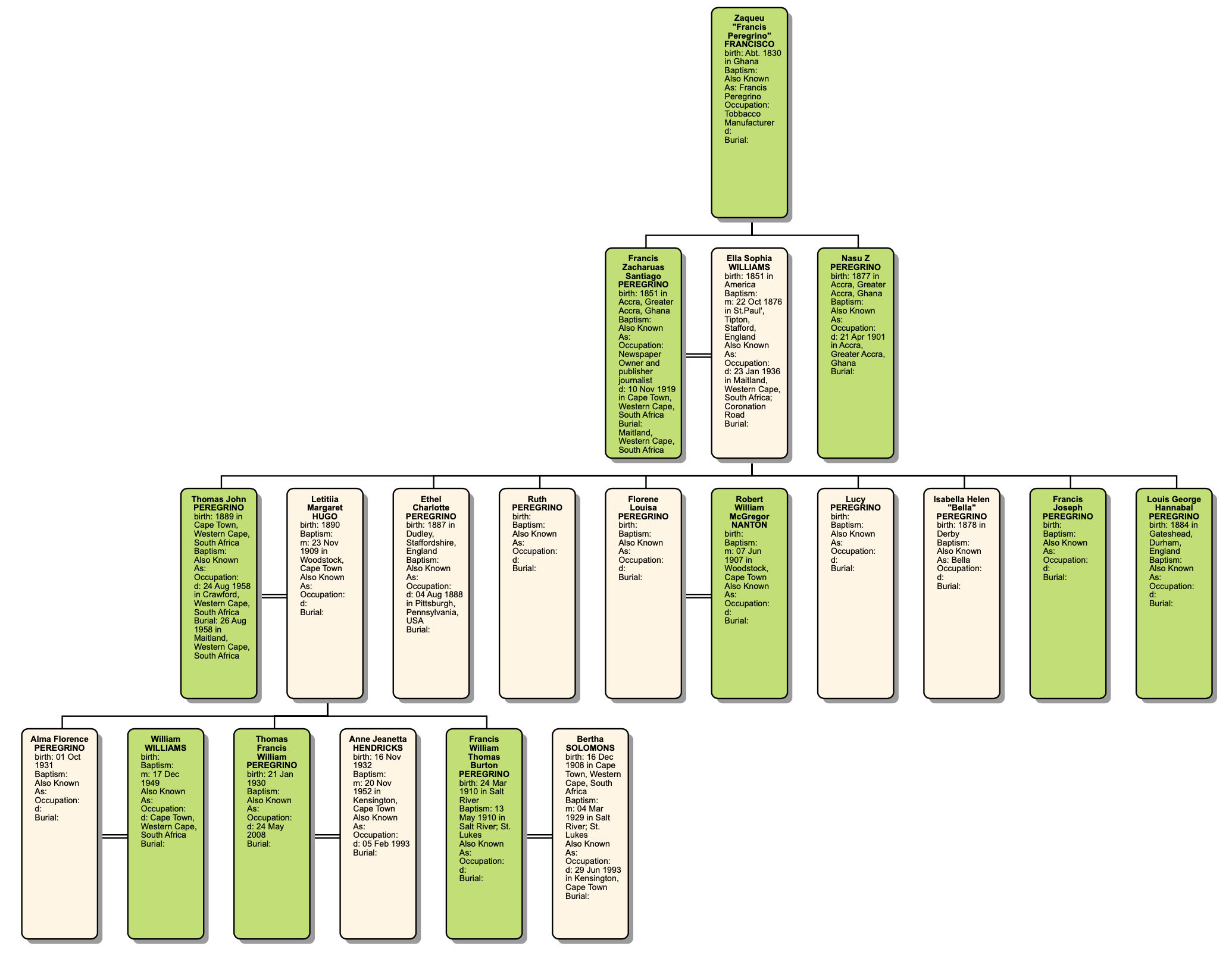 Francis Peregrino was a name I had never heard of before but I got caught up in a friends family history a few months ago when my tenant asked for some help with his family tree.
Francis Peregrino was a name I had never heard of before but I got caught up in a friends family history a few months ago when my tenant asked for some help with his family tree.
When I heard the surname, my first thought was it sounds a bit Italian ?
After some research in the Cape Town archives where I found his deceased estate papers, he turned out to be nowhere near Italian but actually, he came from Ghana. Francis Peregrino was born in 1851 in Accra to Zaqueu Francisco. Nothing is known of his mother. His father was the son of a Hausa woman who had been captured in Africa and taken to Brazil as a slave and who returned to Accra with her children in 1836, becoming part of the Afro-Brazilian community there. After Peregrino completed elementary school in Accra he was sent to Sierra Leone, then England, to study. He remained in England, working in the iron industry and as a clerk, and on 11 October 1876, he married Ellen Sophia Williams, an American, in Staffordshire. Within two years the couple had two children.
Probably because of the economic recession Francis Peregrino moved from the English midlands to Pittsburgh, Pennsylvania, in 1887, and his family joined him there the following year. By 1896 he was publishing a weekly newspaper, the Buffalo Spectator, for ‘coloured people’, in Buffalo, New York. Three years later, he was writing and publishing a similar paper, the Fortnightly Spectator, in Albany, the capital of New York state. Its masthead proclaimed that it was ‘liberal in all things”, and in it, Francis Peregrino sought to link African-Americans to their African heritage. In 1899 he went to London, where he attended the first pan-African conference in 1900. He then travelled on to Cape Town—it seems in part in a vain search for his son Francis Joseph, who had gone to South Africa and there compiled A Short History of the Native Tribes of South Africa (1900). Cape Town was to remain Peregrino’s base for the rest of his life, and his wife and two of his children soon joined him there from the United States.
Francis Peregrino and the South African Spectator
Only two weeks after his arrival in Cape Town, Francis Peregrino began publishing the South African Spectator newspaper, ‘published exclusively in the interests of the “Coloured People’, which for over a decade was what he was best known for. In it, he promoted ideas of pan-Africanism and provided news of the activities of black people around the world. He claimed to be the representative of the Pan-African Association set up by the pan-African conference in London. He hoped to be made American consul in Cape Town, but that came to nothing. Among his numerous business activities there he represented the Cunard line, booking passages for African students to America, and for a time he ran a real estate agency. In 1903 he was a member of a delegation to meet the visiting colonial secretary, Joseph Chamberlain. He expected that with all South Africa under British rule the region would enter a new period of prosperity. He remained a strong Anglophile and continued to look to Britain as the potential saviour of the black people in South Africa.
Francis Peregrino soon became a prominent Capetonian, identifying primarily with the mixed-race coloured people of the city. He was active in moves to create a political movement and helped in the founding of the leading coloured political organization, the African Political Organization (APO), but he soon fell out with its leaders and became a strong critic of the party. His conservatism offended many coloureds and the African Political Organization mocked his acceptance of racial segregation if facilities were equal. After being mugged by a group of whites, he set up the Coloured People’s Vigilance Society, of which he remained secretary until his death. Active in petitioning the government and serving on delegations on a variety of issues relating to coloureds, he failed to bring coloured and black Africans together but developed close ties with some Africans. In 1904 he founded the short-lived South African Native Press Association with Sol Plaatje, a leading African intellectual, and he put much effort into developing ties with a number of African chiefs in the interior, including Chief Silas Molema of the BaRolong, though with little result. Always in financial difficulties—he became bankrupt in 1904—he began to pass information about black politics to the government.

By 1910 Francis Peregrino was suffering from serious health problems, but in that year he published in Cape Town Life among the Natives and Coloured Miners in the Transvaal, and during the First World War he published a recruitment pamphlet for the South African Native Labour Corps. When he died of a heart attack in Cape Town on 19 November 1919 his only asset was a mining concession given to him by King Lewanika of Barotseland in 1906. Only one of his children, Thomas John, remained in Cape Town after his death; his widow and other children settled either in England or in the United States. A man of restless energy and sharp intelligence, whom Plaatje referred to as ‘a master mind’ (Plaatje to Silas Molema, 11 July 1920, Molema papers, University of the Witwatersrand), Peregrino was pompous, often dressed like a dandy, and was difficult to get on with. Not all the copies of his newspaper have survived, but from those that have it is apparent that he was a leading advocate of pan-African ideas in the early twentieth century, and that he helped shape early coloured politics at the Cape. When he died in 1919 he was known as Francis Zachius Santiago Peregrino.
His son Francis Joseph Peregrino was admitted to St. Olav’s Masonic Lodge in London in 1900. He was expelled a year later. The minutes do not state the reason for his expulsion, and his ethnicity is not recorded.

KAB SOURCE MOOC 6/9/2710 REFERENCE 6248 PEREGRINO, FRANCIS ZACCHEUS SANTIAGO. ESTATE PAPERS.
Acknowledgements and Sources: The South African Spectator [surviving copies in the National Library, Cape Town] (1900–) · Report of the South African native affairs commission (Cape Town, 1905) · F. Z. S. Peregrino, Life among the native and coloured miners in the Transvaal (Cape Town, 1910) · F. Z. S. Peregrino, His majesty’s black labourers: a treatise on the camp life, etc. of the S. A. N. L. C. (Cape Town, 1918) · C. Saunders, ‘F. Z. S. Peregrino and the South African Spectator’, Quarterly Bulletin of the South African Library, 32 (1977) · B. Willan, ‘Correspondence: F. Z. S. Peregrino and the South African Spectator’, Quarterly Bulletin of the South African Library, 33 (1978) · G. Lewis, Between the wire and the wall: a history of South African ‘coloured’ politics (Cape Town, 1987) · C. Saunders, ‘From Trinidad to Cape Town: the first black lawyer at the Cape’, Quarterly Bulletin of the National Library of South Africa, 55 (2001) · Q. N. Parsons, ‘F. Z. S. Peregrino (1851–1919): an early pan Africanist’, Tinabantu, 1 (2002) · A. Amos, ‘“Not altogether of ordinary material and timber”: the life of F. Z. S. Peregrino, 1851–1919’ [forthcoming]
Archives
University of the Witwatersrand, Silas Molema papers




